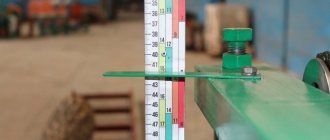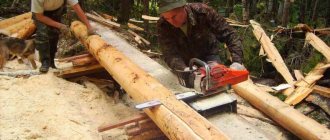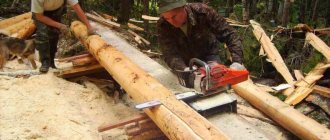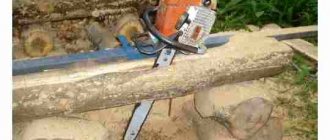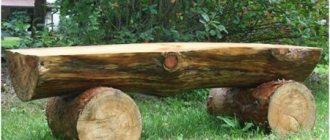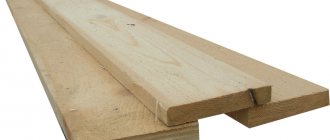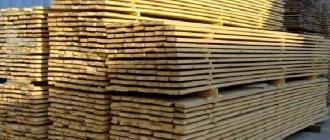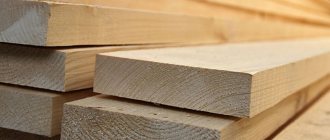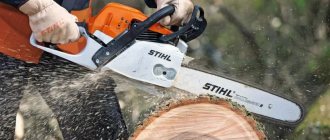Firstly.
We pay attention to all the bends and bulges of the log - a perfectly straight trunk is rare. Therefore, we try to turn it so as to get as little waste as possible from it, such as croaker. When the log is laid and fixed, you should make sure that it passes freely between the guide rollers.
Set the diameter size on the ruler of the sawmill, and to this size add the greatest height of the convexity of the log. This is the bulge that is higher than the diameter of the top or narrowest part of the log.
Using a regular tape measure, measure the height of the highest part, and from this size you begin counting the dimensions of the required material, taking into account the size of the cut, which ranges from 2 to 5 mm.
How to operate a chainsaw correctly - what are the instructions silent about?
We will not give you advice to look at the instructions before starting work - well, who looks there, you might think! Frankly speaking, the instructions supplied with the tool do not always clearly and intelligibly explain how to use it and how to adjust it. Manufacturers of inexpensive saws are especially guilty of this - it is simply impossible to tension the chain using the instructions, because the manufacturer skimped on high-quality printing, and the image of the parts is completely blurry.
We will try to convey to you the basic safety rules as clearly as possible! The first rule is to protect your hands, face and body!
- Clothing should fit snugly to the body, not hang down or dangle. No scarves, laces, bracelets or chains! Once under the chain, they can pull you too!
- Wear strong, thick gloves that will comfortably hold the saw. Gloves will protect your hands not so much from the saw itself, but from lashing branches.
- Wear sneakers that don't slip.
- Protect your eyes! Glasses made from glass that does not splinter are best.
- A helmet, special headphones or earplugs will not be superfluous.
Never leave the saw running unattended and always hold the tool with both hands. First, get comfortable on small branches, conveniently located. At first, your hands get tired quickly, so don’t plan large volumes on the first day after purchasing the instrument. And the tool itself first needs to be tested on small branches.
Preparing for work
Before starting work, it is recommended to sort the trees depending on their purpose. It is necessary to clean them from dirt, remove knots and nails. Sorting is done according to the following criteria:
- trunk diameter;
- curvature;
- number of knots, various defects;
- core diameter.
Immediately before cutting you need to:
- Check the quality of fastenings and connections of parts.
- Check for grounding.
- Lubricate surfaces subject to friction.
- Check that the band saw is installed correctly.
- Check the belt movement at idle and reverse.
- If necessary, change the saw boom by moving the roller on the left side by 5-10 cm.
The log, prepared in this way for sawing, is placed on the frame and securely secured with clamps. You need to make sure that it moves freely between the guides.
Equipment for cutting logs
The most famous type of equipment for dissolving logs into lumber is a sawmill. As the name implies, a sawing machine of this type has frames on which the cutting parts are fixed. By moving the frames along the log, it is cut.
The operation of a band sawmill, a video of which can be found on the Internet, will give an idea of the operation of this equipment. This machine allows you to process logs with a diameter of up to 80 cm and a length of up to 7 meters. The design of band sawmills comes in two types: vertical and horizontal. In both types of such equipment, the blade is responsible for cutting the wood.
Stages of work
To cut a workpiece quickly, you need to proceed in stages:
Take a board of the required size and decide on the tool. If the workpiece is large, you should use a hacksaw with large teeth. For smaller wood materials, use a saw with smaller teeth. The necessary markings are applied with a pencil and ruler. Draw lines that are barely visible to the naked eye. You need to follow the well-known proverb: “Measure twice, cut once.” First make a drink. To prevent the canvas from wobbling, experts advise holding it with your thumb or a special device called a miter box. This makes the procedure much easier. Cut the wood straight, do not sway the body of the tool from side to side
If the hacksaw gets stuck in the material, carefully release it and try cutting again.
If you follow the recommendations, the procedure will go without problems. No special skills are needed to implement it. Anyone can cut the material.
Secondly.
As soon as the width of the cut reaches the required size, and the remaining height of the log has reached the desired size, it is turned over. That is, if you cut a beam, for example, at 150, then both the width of the cut and the height of the remaining log should correspond to this value, even be greater, taking into account the removal of the slab.
Next, we know the final size of the material that needs to be obtained, and we will obtain it.
To do this, after turning the log over, start calculating from the final size until the full height of the log is used, but do not forget to take into account the size of the cut, which, as we already know, ranges from 2 to 5 mm.
For example, you have a log on your overpass that you have cut to a size of 260 mm. Let's turn the log over and continue.
The final result we want to achieve is a carriage with a thickness of 150 mm. Next, in a simple way, calculate that 260 mm-150 mm = 110 mm. We get as much as 110mm of extra material thickness. And it is precisely this that needs to be calculated correctly.
We take this additional size and calculate it to get the block, which has a size of 50 mm, 110-50 = 60, don’t forget the cut, and for us it is 2 mm, 60-2 = 58 mm, then the plank, equal to 25 mm, 58 -25-2=31 mm, hump 20 mm, 31-20-2=9 mm.
As you can see, from our calculations, we get 9 mm slab, 20 mm slab, 25 mm gorge and 50 mm block. And the final size will be 150 mm.
Longitudinal sawing. Peculiarities
Longitudinal cutting is carried out along the growth of the fibers. During such sawing, much more energy is expended, and the machine heats up much faster than in the case of cross-cutting. However, such costs are fully compensated by the fact that the surface of the lumber when cut longitudinally is smooth. But in the case of a cross cut, the surface can be rough and even chipped.
In fact, rip sawing is similar to splitting blocks with an axe, in which the wedge blade splits the fibers held together by lignin, facilitating further splitting. When ripping wood or chipboard, the cutting surface of the tool breaks the lignin and then cuts the fibers with cutting movements.
Often during longitudinal sawing, internal tension in the lumber is revealed, caused by uneven shrinkage of the fibers, which are compressed or, on the contrary, stretched, pinched by the surrounding fibers and remain in this position until sawing begins.
During the implementation of longitudinal cutting, a significant problem arises. It lies in the fact that the edges of the sawn board can close together. But this problem can be avoided. You should not cut boards that have unevenly distributed annual rings, that is, the appearance of which indicates improper drying. Lumber that has cracks is also not suitable for longitudinal sawing.
Longitudinal sawing of wood should be carried out with a reserve for releasing internal stress. This option makes it possible in the future to get rid of flaws using planing or sawing. Do not forget that the discs used for cutting must be sharp and clean, if possible new.
Cutting technology
When choosing a technology for sawing logs into boards, the characteristics and dimensions of the wood are taken into account. There are three ways to work on a band sawmill:
- Sawing into collapse. The tree is cut in a straight line to the end without turning over. The output is unedged boards. The downside is the low quality of the resulting material and a large amount of waste. The resulting boards must be further trimmed. During operation there is a high probability of cracking.
- Circular sawing. After the first cut, the log is turned over to the other side. Usually five revolutions are practiced. The method allows you to cut logs to size with a minimum amount of waste. The disadvantage of this method is the low production speed.
- Sawing timber. The main part of sawing logs is carried out in a circle. The central part is cut out in the shape of a beam. For these purposes, as a rule, the largest logs are used.
The technological process of sawing includes the size of the board and the rotation of the log.
Turning a log
After the sawmill blade has reached the desired height, the trunk is turned over. Unsawn material is measured and calculations are made for its use. Next, the log is turned 900 and the measurements are repeated. When making calculations, it is important not to forget to make allowances for cutting.
First cut
There are two options for starting to cut wood, depending on the selected edge:
- Start cutting from the worst part. In this case, there is no need to take into account the tilt of the barrel. When sawing this edge, boards of short length and a large amount of unedged material are obtained.
- Start cutting with the best part. In this case, the log must be installed so that the saw is parallel to the tree bark.
Since in the first option the best part of the trunk is hidden, errors are possible during further sawing. This method is more suitable when working with low quality wood.
Flipping the log
While working at the sawmill, the log is turned over according to the cutting diagram. The revolution is carried out in two ways:
- Turn 180°, in this case unedged boards are obtained.
- Turning 90° produces unedged and semi-edged boards.
Using the first method, you can get wider boards. The second method is more convenient, since it is easier to turn the log over at this angle.
Methods for cutting logs
Before sawing a piece, it is important to consider how to achieve a high-quality finished product with minimal waste. The wood is of uneven quality; the lower region of the core produces more expensive timber.
When sawing logs, you can obtain the following types of timber:
- Timber is a raw material whose dimensions are more than ten centimeters. The most popular type is a four-edged beam, which has a square shape when cut. It is used as a building material and in the manufacture of furniture;
- The board is a raw material, up to ten centimeters thick and twice as wide as the thickness. Boards are made from logs or beams and are used in construction and furniture production.
Having mastered the basic theory and practice, you can make boards and beams with your own hands.
Sawing tool
Modern band sawmill.
Logging is carried out using a special tool. For normal work by today's standards, you need a special machine for cutting logs with your own hands, which is called a sawmill.
There are two types of sawmills: disk and belt. Circular saws use circular saws and are considered less efficient, as they have a larger cutting thickness (from 6 to 9 mm), less accuracy and depth.
The band sawmill is equipped with a different system: the saw is a band mounted on rotating rollers. The cutting thickness is approximately 1.5 – 3 mm, which is quite economical in terms of waste to chips.
Modern models are distinguished by high accuracy and productivity; they are automated and have a tilting mechanism for lifting and turning logs in the case of circular sawing or sawing timber.
Using a chainsaw, you can only cut a log in half, but if you use a special frame, you can cut the log into boards right in the forest.
Working with a frame and a chainsaw.
Important! The band sawmill is considered the most efficient and cost-effective.
The advantage of sawing logs with a chainsaw
The method of cutting logs using a chainsaw has several advantages.
The ability to work under any conditions - the chainsaw is not afraid of humidity, so specialists can cut logs during the rain; in this case, the equipment will not deteriorate.
High productivity - it is allowed to carry out woodworking throughout the day, but it must be taken into account that the power of the device must be at least 7 horsepower.
Autonomous device - the equipment runs on gasoline and does not depend on electricity; the workplace can be mounted in any area where it will be more convenient to carry out the process.
Chainsaw components
Ease of use - the chainsaw is equipped with a soft start and adjustable chain rotation speed; these conditions ensure that beginners in this business obtain high-quality results.
The undoubted advantage is that the equipment costs much less than a small sawmill. During a breakdown, repairs are inexpensive and do not take much time.
Possible mistakes
As you can see, there is nothing complicated here. Often, inexperienced sawmills make mistakes in calculations when they start counting from zero. For example, if the final size of the material is 150 mm, then there is no need to add 2 mm to it for the cut, otherwise it will be 150 + 2 = 152. There should not be such an error, the cut is calculated only between the material, for example, 50 mm board and 150 mm carriage, we get it as described above, 150 + 50 + 2 = 202 mm.
If it is necessary to obtain edged material, we turn the log 90 degrees and perform the same manipulations as described above.
So you have cut your first log, look at the quality of the material and the accuracy of the dimensions. Make sure your calculations are correct. The main mistake when making calculations is that they forget to take into account the size of the cut. Try to take this fact into account. And don't make such mistakes.
In the future, when you gain experience, the calculation will happen automatically in your head; it will be enough to look at the log.
We are sure that everything will work out for you, we wish you success in your work.
How to cut a log lengthwise with a chainsaw?
To cut a log lengthwise with a chainsaw with high precision, a horizontal design is used. It consists of a strong, rigid frame, as well as a chainsaw bar, which is attached to the frame at the beginning and end of the blade. If necessary, the place where the bar is fixed can be changed, which will make it possible to adjust the width of the cut. The only drawback of this design is the restrictions on the thickness of the log, which should be no more than the width of the cutting blade.
You can adjust the thickness of the resulting material using a guide. In practice, the most difficult thing is to make the first cut. For greater accuracy, you will need to attach another guide to the frame, which serves as a base. During further longitudinal cutting of the log, the surface from the previous cut will serve as the base.
The advantage of this design is its ease of use. Immediately before sawing the log lengthwise, you will need to securely fasten it. Otherwise, it will create vibrations and the cut will turn out uneven. In order to avoid jamming of the chainsaw cutting bar, wedges will need to be regularly inserted into the cuts made.
It must be remembered that before starting longitudinal sawing with a chainsaw, the log must be square in shape. To do this, cut off the top layer of wood on all sides. Only after this can you begin sawing the existing log.
Longitudinal cutting of a log with a chainsaw requires maximum precision. The cutting line must be constantly monitored and wedges must be inserted and removed. Thus, the operator will be able to obtain smooth products, which can later be used for the construction of outbuildings.
Another variant
There are a large number of similar attachments on the market. All of them are suitable for sawing logs into boards, they all have a similar design. But there are also differences. The photo below shows accessories for a chainsaw, which does not require additional accessories or tools to operate. In essence, this is a miniature manual sawmill, which is based on a gasoline saw.
Manual sawmill
The design is complemented by guides and wheels that move along the surface of the log, reducing resistance. There are two pairs of wheels, they are located on opposite sides of the workpiece. It’s convenient, easy, and, on the plus side, the quality of the cut material increases.
The nozzle is attached to the chainsaw in exactly the same way as in the previous case. The main requirement for the work is to accurately install the saw so that it is in a horizontal position. And although the oblique cut turns out the same, it is more convenient and easier when the tool is positioned evenly.
How to cut logs into boards using a circular saw
Because how can you cut a log into boards? And is it possible to cut logs into boards using an ordinary circular saw? Below we will try to answer these questions and carefully outline the process of sawing logs into boards using an ordinary circular saw.
For longitudinal sawing of logs, a machine called a saw frame is usually used, in which the cutting equipment is strip saws stretched in a frame that makes reciprocating movements. On such a machine, the log is cut into boards in one pass. With all this, the log is attached to carts moving on rails. The log moves strictly progressively, without turning around its own axis. The rails along which the cart moves act as guides, so they are positioned quite accurately.
Similar longitudinal sawing of logs into boards can be done using a circular saw, if the longitudinal movement of the log is ensured. It is clear that it is difficult to hold a round log in a suitable position on a horizontal circular table. When sawing into boards, it will certainly roll and “scour” left and right. This situation must be excluded. Let’s say right away that you can’t count on a circular saw as a guide. On the contrary, the saw should be one hundred percent freed from performing such a role. Therefore, to fix the log in a suitable position, we came up with a fairly common additional device - a fin. This is how we christened this device when we adapted a circular saw for sawing small aspen logs during the construction of a Russian bathhouse. Together with a ruler (side guide) installed on the table, the driftwood really helped us.
| Rice. 1. How to cut a log into boards using a circular saw: 1 - clamp; 2 - spacer; 3 - fin; 4 - circular saw; 5 - log; 6 — circular table; 7 — guide ruler; 8 — clamp stop; 9 - gasket; δ is the thickness of the sawn board. |
The thickness of the fin corresponds to the width of the cut, and the fin is installed with the ability to adjust its position. The two of them spread the log onto the boards. They begin to saw the log , simply pressing it against the ruler, in other words, because they are sawing ordinary boards. After the fin is one hundred percent in the cut, a spacer slightly wider than the width of the cut is inserted into the last one (from the end of the log). A piece of flat ratfil came up as a spacer. Next, a special clamp-handle was installed at the end of the log, which, firstly, held the board against the log until the end of the cut, and secondly, by which it was comfortable to pull the log. The spacer file, which had a notch on both sides, perfectly kept the board “in place,” in other words, the board being cut did not move relative to the log due to vibration. The peculiarity of the design of the clamp was that it had an additional jumper, which, when installing the clamp in the center plane of the log, does not allow the clamp to rotate upward around the axis of the clamping screw when acting on it with a hand. To ensure that the cuts when sawing a log are parallel, a flat is formed on the bottom of the log (first with an ax and then with a plane), which will determine the correct orientation of the cut first when sawing. The position of the ruler—its distance from the saw—determines the thickness of the board. So, the presence of a ruler on the table, a flat on the log, as well as a “fin” and a clamp will ensure successful sawing. When working, one of the “sawmills” pulls the logs using a clamp, the other presses the log against the ruler.
If you have to work alone, you will have to design something else. Firstly, in front of the machine (from where you are going to push the log ) you should install a stand under the log (goats) with a height equal to the height of the machine table. Secondly, in front of the saw on the machine table, you will need a clamping device that can ensure contact of the log with the ruler from the beginning of sawing to the end. The clamping device must securely hold the log against the ruler, without creating much resistance to pulling the log during sawing. Such a device, assembled from a small wheel with a pneumatic tire, for example, from a children's bicycle, and a rotary lever is shown in Fig. 2.
| Rice. 2. Clamping device: 1 — nut (rotary), 2 — clamping screw; 3 — front fork; 4 - wheel; 5 — “chain” fork; 6 — carriage unit; 7 - traverse; 8 — tip of the “chain” fork. |
The easiest way to make a lever is from parts of an old bicycle frame. The seat and down tubes are sawed off from the bottom bracket assembly, leaving only the “chain” fork, from which, in turn, the rear fork is separated. The front fork, having previously removed the tips from the feathers, is welded to the “chain” fork. A handle from a bicycle handlebar is placed on the rod of the front fork. In the middle of the “chain” fork (opposite the front fork), plates with slots for installing the wheel axle are attached (welded) to its stays (see Fig. 2). In addition to this part, you will need to make a rotary nut - a support for the pressure screw, the screw itself, a traverse and the lever axis. You will also need some fasteners (nuts, washers, pins), shown in Fig. 2.
Before sawing the log into boards, flats are formed on it (bottom and sides). The side flats of the log ensure the strict direction of its forward movement when sawing and the constancy of the force of the pressure wheel, which makes the work calm and confident. Before starting sawing, the wheel is pressed against the log manually, while simultaneously turning the screw using the handwheel. The screw in this device serves only to fix the position of the lever with the wheel, therefore it is equipped with a small handwheel, for example, from a water tap. This makes it possible to dose the force of the wheel on the log “by touch”.
Now the market offers a wide range of woodworking equipment. Many varieties of motor and electric saws have appeared. If you are going to cut logs into boards for a long time and seriously, and you don’t have a machine yet, consider using a saw from a chainsaw as a saw unit. Its drive will have to be located under the machine table, like a circular saw, and the saw itself will have to be installed vertically above the table. Using such a machine, you can cut much larger logs into boards and prepare lumber for doors, windows and other large products.
Chainsaw
Before picking up a chainsaw, you need to properly cut the log. In this way, it will be possible to obtain the maximum amount of high-quality boards with a small amount of waste.
To begin with, a mark is applied to the tree that corresponds to the type of lumber planned. Then the log is fixed on the work surface so that it does not move or dangle.
Using the rip saw attachment, attach it tightly to the body of the chainsaw and prepare the base surface against which the cut will be made. Under no circumstances should you put pressure on the saw; it should move smoothly along the working surface. Well, for the convenience of work, it is best to invite a partner. Extra hands will help secure workpieces to insert wedges into the cut.
Setting up a sawmill
Selection of Coolant Solution
It is incorrect to saw on a band saw using water as a lubricant. It is better not to use lubricant until sawdust has been “rolled” onto the saw. If this happens, the optimal treatment is: 1/2 lubricating oil for chainsaw tires, 1/2 diesel fuel. The mixture is applied on both sides of the saw blade, but the amount of cooling solution is small.
This lubricant will extend the service life of sawmill pulleys and reduce the number of boards with traces of blooming.
Strain relief
Saw tension on a band sawmill
The blade heats up during sawing, which causes it to stretch in length. After cooling, the tendency to contract begins. At this moment, overload occurs due to excess tension, and cracks may appear.
The blade remembers the shape of the pulleys; deformation of the pulley belts occurs, which can lead to vibration of the blade. The hump on the belts is jammed, ensuring self-centering of the saw. When stopping sawing, the tension on the saw must be removed.
Band saw routing
The optimal wiring is considered when there is a mixture of 2/3 sawdust and 1/3 air between the saw blade and the wood being cut. If 80% sawdust is ejected, the saw is set correctly.
If there is a lot of loose sawdust on the cut, and there are scratches on the surface of the board, the saw will move more than necessary. The saw functions jerkily. If the spread is insufficient, hot sawdust, tightly compressed, will remain on the surface of the boards during the sawing process; this situation has a detrimental effect on the saw. And after cutting the wood, waves will remain on the material.
Before cutting, the logs are sorted by diameter:
The best saw settings
- For a larger diameter, the spread increases, but it is performed only on 1/3 of the tooth from above.
- For soft wood, the spread should be increased; sharpening should be done after preparing the equipment, with obligatory observance of the tooth shape.
The indicator of the divorce device works in a stressful mode and often goes astray, so constant checking is necessary.
It is recommended to maintain a sharpening angle of 10–12 degrees, soft wood – up to 15 degrees, hard and frozen wood – 8–10 degrees.
Sawing speed
Increasing the sawing speed results in a cleaner cut, but the service life of the saw is reduced. If the quality of the cut decreases, it is necessary to reduce the feed speed. For the initial 5 minutes, the equipment operation indicator should not be more than 1/2 of the maximum value.
Safety precautions when working with a chainsaw
How to cut correctly with a chainsaw?
This question arises for everyone who has recently purchased this instrument. And many do not read the instructions, relying on their theoretical experience and knowledge. And this is one of the critical errors that will lead to mechanism failure or dangerous injury. Safety precautions must always be followed.
Preparatory work
Before operating a chainsaw, you must ensure that the chain of the device is properly tensioned.
Pull a little on the top links of the saw and you will see the shank come out a few millimeters from the bar groove. Make sure that the lower links of the chainsaw do not sag. Next, pull the chain by hand, and if the tension is too strong, then loosen the chain. Check that the inertia brake is in the correct position, i.e. his hand did not touch the handle. When turning on the chainsaw with an offset inertial brake, it will lead to the clutch disengaging.
After checking the chain tension, you can begin threading the saw. Place the tool on a horizontal surface. Add fuel and oil to lubricate the chain and engine mechanism. A good option would be a fuel mixture consisting of gasoline and adhesive oil.
For the motor and chain, select a special lubricant designed specifically for chainsaws. The components of this lubricant will guarantee a long life of all engine elements and cutting mechanism.
After completing all the above procedures, start the chainsaw. The engine should be cold at this moment. Place the saw on the ground and make sure it is stable.
Turn off the brake and turn on the ignition. Hold the front handle with your left hand and place your right foot on the back handle. To start the engine, pull the starter. Disconnect the inertial brake and press the gas several times to warm up the engine. Next, check whether the oil is flowing well to the chain. Once you are sure that everything is in order, you can begin your work.
How to cut down trees with a chainsaw
Many people wonder how to properly cut trees with a chainsaw?
Before you start working, you need to familiarize yourself with a number of important rules for using this device. First, you need to hold the chainsaw with both hands and wrap your fingers tightly around its handle. Place your thumb under the front handle of the unit. Secondly, you cannot stand directly behind the chainsaw. The standard position when sawing is slightly to the side of the mechanism itself.
Always work with a straight back . For a comfortable position and balance, spread your legs wide. Put the chainsaw on the brake while moving. Start sawing with the edge of the tire. Failure to follow these instructions may result in serious injury.
To work with a chainsaw, buy yourself special protective clothing, which will consist of a helmet and mask, a bright jacket and pants. This shape will protect you from saw cuts.
How to cut a felled tree with a chainsaw
How to cut boards with a chainsaw with your own hands?
This question arises for beginners. Below we will describe in detail how to properly cut wood.
The wood is cut at full throttle using the section of the tire closest to the mechanism body. And for each material it is necessary to use its own specific cutting method.
If you want to cut branches from a tree, you need to stand to the left of the trunk and start cutting at the bottom. Perform all movements slowly. Cutting is done using the nose of the tire, namely the upper and lower blades of the chain.
Cut branches that are thick and difficult to process in several passes. Start cutting with a chainsaw from the end to the base of the tree trunk. It should also be noted that without certain support the trunk may roll, and before starting the work process, make sure that the tree is secure and stable.
After trimming all the branches from the trunk, you can move on to the next stage - cutting the tree into several parts. Be very careful because... Due to the intense jerks of the chainsaw, the barrel may roll towards you.
If the saw blade gets stuck in the wood, do not pull it out. Turn off the saw motor and tilt the barrel slightly.
If you decide to cut large trees with a chainsaw, then you definitely can’t do it alone. You will need at least one assistant to help you in case of an emergency. Before starting cutting, conduct a visual inspection of the tree trunk for the presence of dry and rotten branches, because... they may fall on you.
It is also worth paying attention to neighboring trees so that they do not interfere with your work. Next, stand to the right of the tree and hold the tool to the side. This will significantly reduce the load on your arms and spine. The whole process is divided into undercut and main undercut. Start cutting at an angle of forty-five degrees to one-fourth the depth of the tree trunk. With such actions, the tree will fall in the direction you want. If a tree falls, try to remove the chainsaw quickly enough.
Chainsaw care
Before starting work, carefully inspect all teeth and clean them of accumulated chips, dried oil and dust. If the chain is loose, be sure to tighten it. After completing the work and cleaning the tool, be sure to check the condition of the chain oil and lubricant. It is also worth paying attention to the air filter. If there are shavings in it, simply remove them. Sometimes it is necessary to rinse the filter.
If you use a chainsaw frequently, you will have to periodically replace some parts, such as the bar, anti-vibration system, chain and drive sprocket. If you do not change these spare parts, this will have a bad effect on the overall condition of the chainsaw.
When purchasing a chainsaw, remember that this is a very complex technical device, and it requires qualified handling and special skills. You can easily learn how to use a chainsaw in a short time, but do not forget about general safety precautions. Regularly undergo technical inspection of the saw, because if you do not take it seriously, the chainsaw will fail, and you may get injured.
We advise you to carefully read the information described . And if you follow all the rules of use and safety precautions, everything will be fine.
Useful tips!
In order for sawing at the sawmill to proceed without any problems or complaints, you should pay attention to the following factors that may arise during the work process:
- Uniform feeding speed of material during operation;
- Correct blade shape;
- Carrying out the correct layout of the saw;
- Do not allow resinous substances to stick to the canvas;
- Watch the saw teeth.
Maintaining safety while working
To avoid failures and accidents, you must follow safety precautions when working with materials and tools:
- When working, do not allow strangers to enter the work area, especially children.
- While working,
you should use protection from noise and sawdust that is thrown during cutting. - You should have a first aid kit with everything you need to use in case of cuts.
- When using a circular saw, it must be equipped with a protective cover.
- Do not pour gasoline into a hot chainsaw
. - Use the chainsaw only for its intended purpose and do not run it at full power if it is not working.
- Do not press the saw too hard while working.
- The log for sawing should be installed on the right side.
Chainsaw. This is a handy tool that you can use to make your own boards. It is suitable for use on a private farm where it is necessary to renovate or build new outbuildings. In such cases it is not required. Therefore, they can be easily cut from any logs of the required size. Once you get the hang of it, the work gets done quickly and the quality of the boards is excellent.
Post Views: 8
Chainsaw Partner 340 Malfunctions And Their Elimination
Why does the Huter Electric Saw Chain Often Weaken?
Sawing map
The sawing map is a calculation of the optimal amount of finished lumber from one log. You can calculate it yourself for each specific log diameter, or you can use a computer program that greatly facilitates the calculation, and the price of which is quite affordable.
Material yield after cutting wood
Or the source could be a regular sawmill reference book. The result is a table that is used as a basis. The sawmill attachment should always be oriented to its data in order to obtain more lumber of any type of wood.
First cut
Of all the problems facing the sawyer, deciding which side of the log to start cutting on (and therefore which cut surface to open first) is the most important. (As already mentioned, we divide the log into 4 sides, each of which extends along the entire length of the log and occupies 1/4 of its circumference). The choice of the first face is determined by the position of all the others. Before sawing begins, a log can be cut in millions of ways, but only a hundred of them will actually be profitable! Having decided on the first cut, the sawyer only has a few thousand other decisions left to make.
In the case of circle sawing and sawing timber, two basic rules apply.
Rule 1. The worst edge of the log is cut first, without any regard to the taper of the log. (Running a log means raising or tilting the log so that the saw runs parallel to the bark). Since this is the worst part of the log, it will make short boards and a lot of slabs. Since we do not take into account the taper of the log, this gives us the opportunity to cut parallel to the bark from the opposite, better side of the log, without lifting or tilting the log. This means that from this best part of the log more boards of high quality will come out, which also match the length of the log.
Rule 2. Cut the best edge of the tree first, taking into account the taper of the log. This means that the log needs to be raised or tilted so that the first cut is made parallel to the bark.
The end result of both methods will be approximately the same, but the second method has one advantage: in this case, it is easier for the sawyer to position the log (i.e., rotate it), because the open edge is the cleanest and has no defects. In the case of Rule 1, the best part of the tree is opposite the open face. It is not visible, and it is impossible to accurately position the log. Typically, if the wood is of good quality, rules 1 and 2 work pretty much the same. However, if you encounter a worse log, take rule 2 into account.
Log sawing tool
The selection of equipment for sawing workpieces is determined by many factors.
These include:
- Scope of work
- Dimensions of workpieces for cutting,
- Quality and volume of timber.
To cut large batches of workpieces and make more high-quality raw materials, it is recommended to use a sawmill. This is a wood processing unit, the functional part of which is a variety of saws.
The best option for longitudinal sawing of logs up to six meters long and with a diameter of 0.2-0.8 m.
At large woodworking plants with huge production batches, special points for sawing wood are used. You can cut logs of any diameter point by point, obtaining timber of the required parameters with a well-processed top layer. The lines are characterized by excellent efficiency.
For longitudinal cutting, you can make your own wooden stop - the main ruler that helps you cut the log perfectly. The stop consists of 2 wooden boards, one of which is fixed at the end in the central part of the other.
The structure is attached to the workpiece with self-tapping screws so that the outer edge of the vertical board is located below the outer border of the log. The interval between the top area of the log and the top area of the board calculates the thickness of the sawn slab.
Sawing schemes
You should decide on a work plan in advance.
One of the most important tasks of the sawyer is to choose the most rational cutting scheme. The compliance of materials with the goals set, the amount of output per unit volume of forest and, as a result, the profit of the enterprise will depend on this.
The master must have impressive experience and a special flair for the material in order to determine in advance the order of work, where to start and how exactly to act in the process. Such a skill comes only with time as a result of long work at the sawmill.
There are three standard log cutting schemes:
| Sawing diagram | Peculiarities |
| Circular | After removing the first slab, the log is turned over 180˚ and placed on the resulting edge. Then during the process it is turned over 180˚ or 90˚ more times, usually at least five turns are practiced. |
This is the most rational and economically beneficial method, however, in the absence of mechanisms for turning over when manual labor is used, the resulting productivity may be reduced
Homemade attachments
Masters have long learned to do a lot of things with their own hands. There is a huge variety of frame designs on the Internet that allow a chainsaw to cut logs into boards. There are simple manual options, there are large complexes of a frame and guides, with the help of which the tool moves or the log rises/lowers. One of them is in the video below:
Please note that the structure is assembled from metal profiles, which makes it reliable and stable. At the same time, the machine (it simply cannot be called otherwise) is equipped with mechanical gearboxes that simplify the process of moving the workpiece barrel and the chainsaw. No manual effort, just turn the handle from the gearbox. In this case, the thickness of the boards is adjusted by lifting the log, and not with a gasoline tool.
Another option is an attachment that helps make cuts not in a horizontal plane, but in a vertical one. The design is simple, but it is more difficult to work with because you have to make an effort to hold the chainsaw. In addition to the device, you have to prepare a metal strip or board, which is attached to the log in the longitudinal direction. It is on this that the frame-nozzle rests when cutting is carried out.
In addition, this option is more dangerous, because nothing holds the board being cut. She may hit her leg if she falls. So the process needs to be carried out carefully. The video below clearly shows how this option works.
Another setup that the manufacturer called a carriage. For this purpose, such a frame structure was made from a profile pipe and several wheels, which will give the device some mobility in terms of moving along the workpiece barrel. They are also a kind of stops that do not allow the chainsaw to move from side to side.
Carriage for cutting logs into boards
In addition to the carriage, a regular aluminum ladder is used, which acts as a guide element. It is attached to the log with clamps on nails or screws.
Aluminum ladder fastening
Please note that the width of the ladder must match the distance between the carriage wheels located at its different ends. The staircase must be placed in a horizontal plane using a building level. It is leveled by placing pieces of boards of different thicknesses underneath it.
The prepared chainsaw with the carriage is installed on the stairs. Turn on the engine and push along the workpiece with your hands, cutting off its upper part.
Start of sawing process
From the side the process is visible better. Here you can see a carriage with wheels, a ladder, a log lying under it, and how the cutting process is carried out.
The design of this type of device is quite complex. But of the many homemade manual options, it is better, more convenient, and more reliable. It became possible to adjust the cutting height horizontally by first installing a ladder along the horizon.
Chainsaw - a tool for all occasions
Most chainsaw owners have no idea what capabilities are hidden in this seemingly single-function tool. We are talking about what functions, besides cutting logs into firewood, a chainsaw can perform in skillful hands. But just think - the tool is absolutely autonomous, fill the tank with fuel, and work where it’s convenient for you!
A wide range of work is determined by a powerful, compact and safe gasoline engine, which has a very unpretentious “character” and the ability to work in the most difficult conditions. Another good thing about a chainsaw is its sealed fuel supply system, which, in combination with a diaphragm type carburetor, allows it to work in a variety of positions, perhaps not upside down. In addition, the designers have provided reliable protection of components from overloads and breakdowns in the form of a centrifugal clutch.
Look at the chainsaw from a different point of view - you are holding in your hands a tool that is amazing in its capabilities! This is a universal drive for a wide variety of devices, capable of not only sawing wood, but also cutting metal and stone, pumping water, drilling wells, and even serving as a low-power engine!
Recommendations for cutting
Sawing logs on a band sawmill can be effective and easy, depending on how you approach this process.
By planning your efforts and time in advance, it will be possible to cut logs with greater productivity. You can make this process most effective by using the following recommendations:
- When cutting logs, it is recommended to use only sharp saws. An indicator that the electric saw has become dull will be its frequent pulling up during cutting, since the dull blade heats up and expands, i.e., it loses tension. Thus, the saw begins to wander, get stuck in the log, and create problems in pulling it back. A timely replacement saw will help avoid such situations.
- Avoid ruptures. Daily inspection and lubrication of the sawmill does not take much time compared to the cost of replacing the bearings on the flywheels, as well as the cost of spare parts itself.
- Prepare logs for cutting in advance. Before you start cutting down trees, you need to wash them from dirt and use a metal detector to remove any nails driven into them that might have remained in the logs after the signs were removed from them. Before sawing the logs, the procedure for cutting off knots and protruding knots on it using a chainsaw will help you save time, and you will also need to trim the end of the tree being cut in advance so that it fits the diameter of the log as accurately as possible.
- When cutting timber, it is necessary to immediately edit it. It is necessary to cut off the edges immediately after sawing the log into beams directly on the band sawmill: first on one side, and then on the other, and so on until the last board, until the entire process of sawing and processing the sawn log is completed.
Sources
- https://molotok34.ru/stanki/kak-pilit-na-lentochnoj-pilorame.html
- https://lesoteka.com/obrabotka/raskroj-brevna-na-lentochnoj-pilorame
- https://instanko.ru/drugoe/raspilovka-kruglogo-lesa.html
[collapse]
